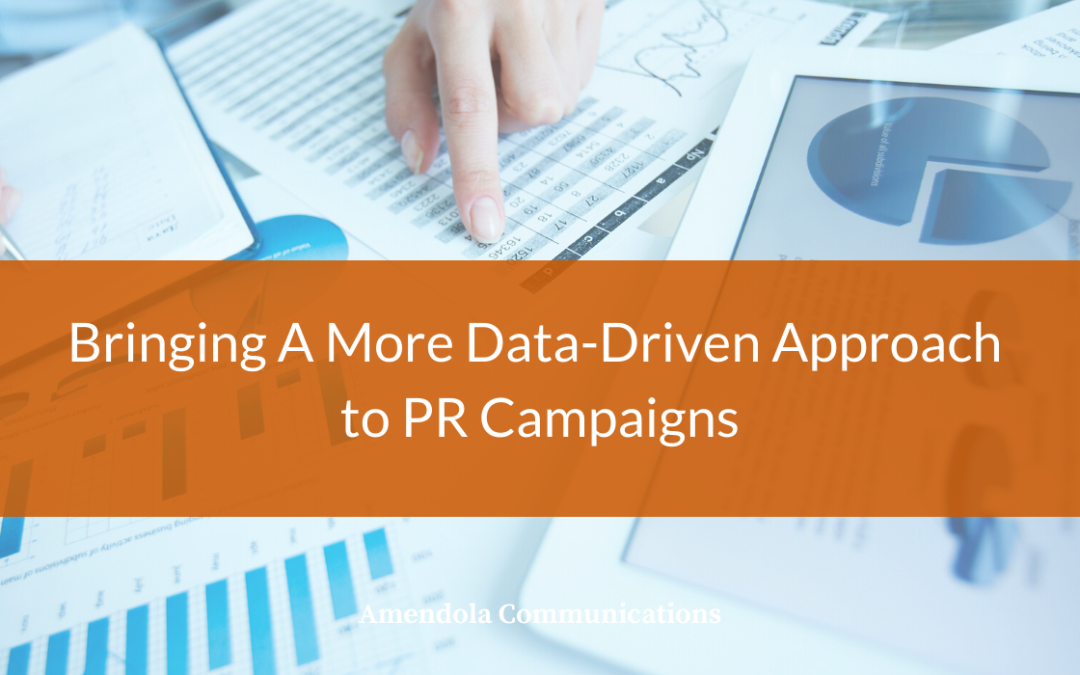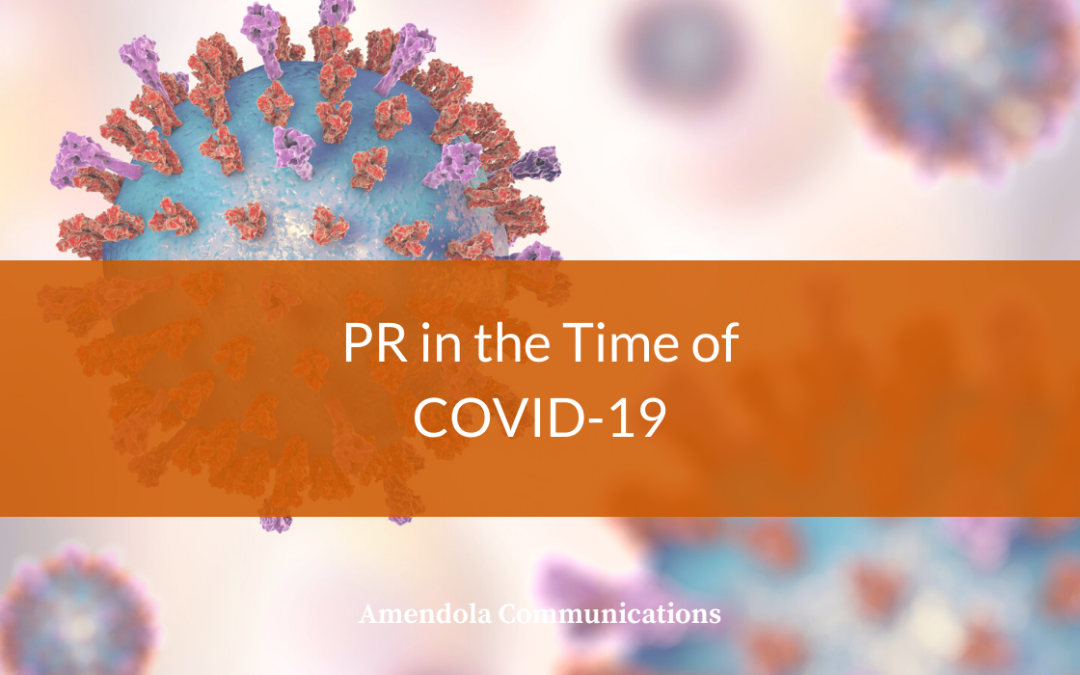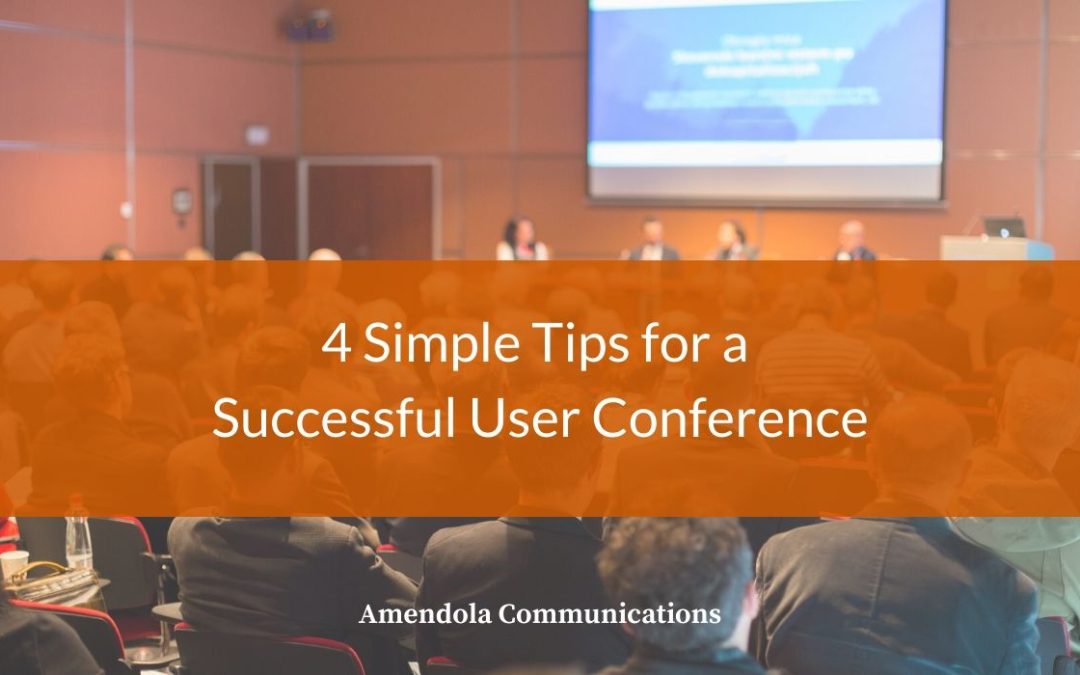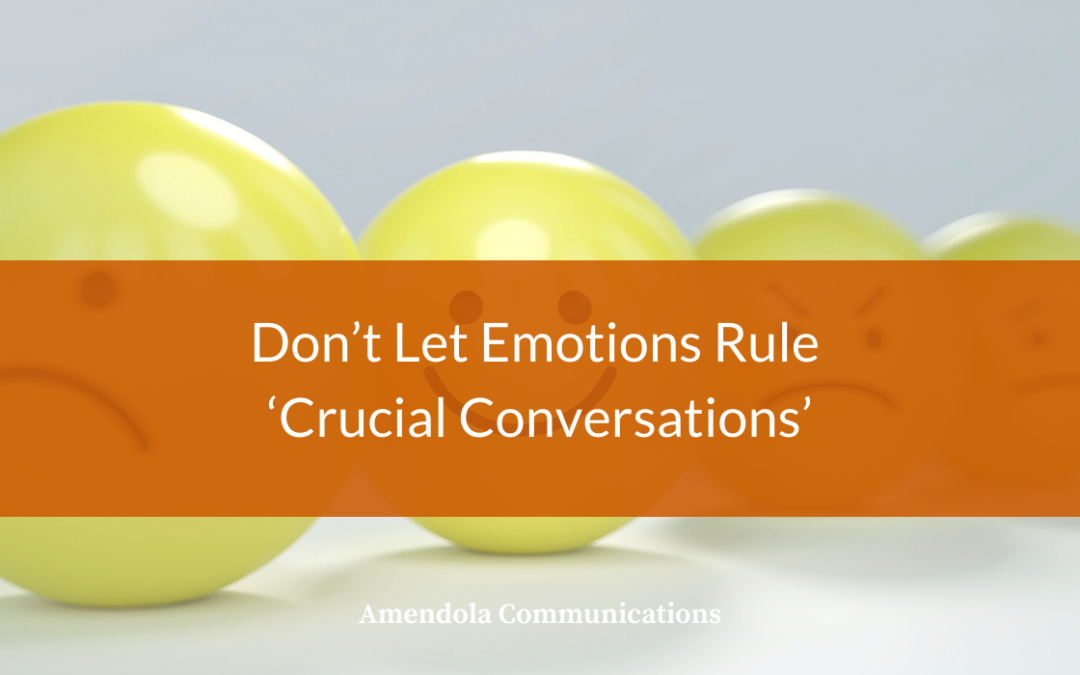
by Morgan Lewis | May 6, 2020 | Blog
Writing is difficult, especially when you work from home, as many of us do here at Amendola. As I write this, for example, the COVID-19 virus pandemic is sweeping across the U.S., with New York City and Louisiana emerging as hot spots. I point that out for two reasons:
- To show that we at Amendola compose these blogs weeks in advance (and you should do the same for your site’s blog)
- To illustrate how difficult it is to write when there are many distractions
Not only is the local and national news about the pandemic a constant source of distraction, but I am also now home with my wife, who has a full-time career, and our 2-year-old and 5-year-old sons. It’s not an ideal environment for writing, but that’s the thing about writing: There never seems to be a good time.
Give Yourself A Deadline
At Amendola, most of us write a lot of content and all of it comes with a deadline. The concrete date itself can be a huge motivator, but even if you are not given a deadline by a manager or colleague, create one for yourself and let others know about it, such as the colleague who is going to review it before it’s shared with the rest of the team or your boss. Once you’ve set a realistic date for completion and shared it with others, it motivates us to put distractions aside and get started because we feel accountable to the other person and ourselves to finish the content.
Ignore the Monkey
Apart from my kids who demand quite a bit of attention the distraction I feel is entirely self-inflicted. Writer Tim Urban, in one of the most entertaining blog posts ever about procrastination, blames this type of behavior on the “Instant Gratification Monkey” who takes control of our brain from the “Rational Decision-Maker” who we rely on to get our work done. The monkey, however, causes us to repetitively check the news, watch videos, scroll social media sites, or even clean the refrigerator instead of completing our cognitively challenging work.
The Instant Gratification Monkey is only interested in “maximizing the ease and pleasure of the current moment,” Urban writes, so we need to resist that urge. That starts with putting away all distractions as much as possible (I’ve put a website blocker on my laptop and sequestered my phone in the kitchen) and creating a plan for your content.
Get the Plan on the Page
A good way to fight distraction while still not actually writing is research. Whether it is a blog post, white paper or thought-leadership article, you should have adequate source material available beforehand, but don’t let it stop you from putting words down on the page. There is a tipping point and it varies depending on the length of content, the audience, publication, etc. between inadequate research and too much.
A good way to figure out if you’ve reached that tipping point is to start listing the points you want to convey, or the most interesting facts from the research so far. That should give you a good idea if there are gaps that need to be filled with more research.
Simply getting started in this way can in itself be the most important part of the writing process because, as James Clear, author of the bestselling self-help book Atomic Habits, writes in his blog: “the willingness to start is the littlest thing in life that makes the biggest difference.”
Editing is the Work
Some non-writers may be surprised once they start writing how smoothly their content is flowing from their fingers. After this revelation is usually when they realize that the composing part of writing isn’t the hard part of the process, but rather it is the editing. It’s the reading, re-reading, moving words around and cutting that’s the most tedious part of writing and the part that elicits almost as much procrastination as getting started. Fortunately, when you have arrived at the editing point it’s likely closer to the finish line. As both Urban and Clear point out, that momentum helps move you faster toward completion, even if you are not 100% satisfied with your final draft.
It’s Never Going to be Perfect
Hopefully, you will have someone reviewing and editing what you wrote to make it better. Everyone needs an editor, especially if you’ve been drafting a piece of content for a while without working on anything else. When the content is still very fresh in your mind, it can be difficult to assess its quality because you have edited it so many times and can remember the changes. If your deadline won’t permit a day or a week between your most recent draft and another look, turn the content in anyway. Another round of revisions before outside feedback won’t significantly improve its quality. As internal medicine physician Alex Lickerman M.D. puts it: “Recognizing that inflection point the point at which our continuing to rework our work reaches a law of diminishing returns is one of the hardest skills to learn, but also one of the most necessary.”
Experienced writers have a keen sense of that inflection point. For professionals who write less often, I would urge you to always edit and revise those first couple drafts, but then trust your gut when you feel a piece of content is done. A good editor or at least a proofreader will be able to truly review the content with fresh eyes and make changes or offer recommendations.
During this time of powerful stress-induced distractions, we can still get writing and work done. We just have to turn on “Paw Patrol,” ignore the Instant Gratification Monkey, do the research and start writing. The progress you make, even if you don’t finish the content, will reduce your stress and remove the self-inflicted
obstacles to completion.

by Jodi Amendola | Apr 29, 2020 | Blog
As the presidential election cycle heats up we are hearing more and more about how certain campaigns are making (and have made) imaginative use of data to help boost their candidates’ chances of success. A good example is a story I heard recently about the early stages of Michael Bloomberg’s now-abandoned campaign.
According to the story, the campaign did some research to determine where the 50-100 most influential TV political talking heads live. They then made an effort to place yard signs in those neighborhoods, and perhaps all along the pundits’ route to work, to make it look like there was an organic groundswell of support for the former mayor of New York City so they would talk about it.
Pretty clever if true, wouldn’t you say? What’s more significant is that it’s plausible.
We’ve all heard stories about campaigns using sophisticated analytics to micro-target ads on social media. They may have hundreds or thousands of data-driven variations designed specifically to push exactly the right buttons of the individual who sees those ads.
In other words, the ads I see may be very different than the ads you see or our neighbors see. But they are meaningful to each of us.
One area of integrated marketing that has typically been difficult to quantify in this way is public relations. This is due to the nature of PR itself.
When you see an ad on the Internet or TV, receive a marketing email or even get a piece of snail mail, there is usually a next step you can take. You can click on link (sometimes inadvertently, thereby dooming you to forever see messages that make your blood boil), heed the urgent yelling to “CALL NOW!!!,” text a five-digit number, etc.
With PR, however, that is usually not the case. To respond to an article that captures your interest you actually have to go out of your way (the horror!) to search for a company. Or at least type in a URL. Without an action, it’s difficult to get a read on just how effective the PR campaign has been in capturing the hearts and minds (and potentially the wallets) of your target audience.
Difficult, but not impossible. Earlier this year I wrote the blog post “Three Ways to Make Your PR Campaigns More Data-Driven” for the Forbes Agency Council. It offers some key insights not only into how to measure the effectiveness of your PR campaigns but also what to measure. (SPOILER ALERT: It’s not ad equivalency, which has always been one of the worst measures of the quality of PR.)
If you’d like to learn what those ways are, follow this mercifully shortened link to the original article.
While PR may still not have the sophisticated analytics of the more advanced election campaigns, it has definitely come a long way in the last few years. Be sure you’re up on all the latest options so you can take advantage of them.
There are plenty of classes you can take. Or you can shortcut the process by letting a data-driven PR agency like Amendola Communications do it for you.
Interested? Send me an email or shoot me a text and we’ll help you make your campaign a winner.

by Matt Pera | Apr 22, 2020 | Blog
“When the going gets weird, the weird turn pro.” The great gonzo journalist Hunter S. Thompson said this many years ago, and it certainly holds true today. During these disorienting times of COVID-19, in the year 2020, things are inarguably weird. And scary. And uncertain.
And in the midst of this chaos, those of us who are still fortunate enough to have jobs need to keep pushing along. It should not be lost on any of us who are steadily working through this era of social distancing and self-quarantining that an insane number of people have lost their jobs since COVID-19 began to run roughshod through every aspect of our lives.
It also should not be lost on any of us sitting at home typing away on a laptop (as I am right now) that there are exhausted doctors, nurses, first responders, hospital janitors, etc., on the front lines battling this virus every day. Delivery drivers, Amazon warehouse employees, grocery store stockers and cashiers, waste collectors, and many others are showing up to work everyday and putting themselves at risk because it’s either work or join the millions who filed for unemployment last week.
Strange and scary times indeed.
I don’t say all of this to sound preachy. Most of you don’t need to be told anything I’ve written so far. But it’s March 30, and I have a blog to write. And what else am I supposed to focus on?
During the head-spinning month of March, enough happened to pack years. Mondays, Tuesdays, Wednesdays at this point we can just call them all “day.” Bleary-eyed neighbors walk their dogs for the third time in 12 hours and binge-watching the Tiger King reminds us that things can, indeed, still surprise us with their craziness.
And those of us in the PR world still need to work. But how? And on what?
At our PR firm, we are fortunate to exclusively represent healthcare and healthcare IT clients who work directly with providers and insurance firms. These companies offer population health management solutions, telemedicine, and air ambulance services (to name just a few). Work will continue at a break-neck pace for them. And that means we must make sure the public is aware of how these companies can help during this pandemic.
Our clients can allow patients to video chat with doctors on their phones or computers; they can enable providers to identify patients more at risk with respect to COVID-19 and zero in on who needs immediate outreach; they can provide life-saving air ambulance transport to patients in rural areas.
But many other companies don’t have such a direct connection to the conversation that is dominating the world. And those companies and their PR/marketing/advertising agencies might feel like they have nothing worthwhile to add to the conversation that doesn’t seem like a stretch or, even worse,
exploitive.
The best thing you can do as a PR professional is listen. Listen to the news. Set Google Alerts that have keywords related to both your clients’ specialties and news about COVID-19. Listen to your clients. Find out what they are doing for their employees during this time that could set a good example for other companies. What are they contributing to the battle against this virus? What are some innovative ways they can help all of us get through this?
The more you discuss these elements with your clients, the more angles you will find that add to the conversation in a constructive way. Creativity, now more than ever, is key.
The going is weird, friends. And it’s going to be weird for a while. So, we need to be the pros.

by Brandon Glenn | Apr 15, 2020 | Blog
For attendees, a user conference is a little like a mini-vacation.
It’s an opportunity to bask in the luxury of being a valued customer, perhaps with a stay at a beachside resort with catered meals and evenings of receptions with open bars. Not a bad assignment if you can get it.
For the marketing and communications team tasked with seamlessly pulling off a sparkling, well-attended event that woos customers new and old while simultaneously showcasing the best of the organization’s product and service offerings, it’s a whole other story.
From planning a pre-conference messaging strategy to identifying an appropriate venue to staging informative and engaging presentations, there is a seemingly endless list of tasks that go into conducting a successful user conference. No one blog post could cover all of the best practices and important steps, so this post will serve as a brief summary of simple tips and observations from personal experience that virtually any organization can follow.
There’s an app for that: Event apps, such as AttendeeHub, can be customized with important conference information such as schedules, maps, agendas, wifi connectivity, speaker background and more. An event app’s push notification feature is particularly useful when sharing information on last-minute schedule and location changes, ensuring attendees have a source for all the latest news and announcements about the event. At a recent event, I consulted the app several times per day to plan my own activities around agenda items and was happy that I didn’t have to bother the event’s organizers with every little question that popped into my mind.
Go easy on the sales pitch: The beautiful thing about a user conference is that the vast majority of attendees are already your users. They don’t need a “Come to Jesus” moment of conversion that changes them from skeptics to believers. That’s important to remember so your customers/attendees don’t feel like they’re being beaten over the head with constant sales pitches over the course of the entire event. Certainly, it’s ok to mention new product features or service offerings, but as always, keep the focus and orientation on what you can do now and in the future to solve customers’ most pressing problems.
Keep it moving: Freed from the pressures of having to convert nonbelievers, conference organizers should extend this collegial feeling toward the event’s programming. In other words, create a tone for the event that feels light and engaging to attendees. Focus on sharing successes and problems that your solution has helped clients overcome, rather than getting bogged down in minutiae. The last thing you want is roomful of slack-jawed, bored attendees staring at their phones (even if they are just consulting the event app!) while speakers drone on during endless presentations.
Give me a break: Keep individual sessions to an hour or less. Schedule frequent breaks, and why not end programming on one afternoon at 3 or 4 p.m. to give attendees some time to enjoy their surroundings? The more you make your conference feel like a mini-vacation for customers, the more likely they’ll be to return year after year.

by Philip Anast | Apr 8, 2020 | Blog
There is no shortage of books on communication in the workplace to improve collaboration and maximize teamwork. Harvard Business Review also provides wonderful, well-researched articles that can help one improve communication and leadership capabilities.
But one book that I’ve read and re-read over the years stands out: “Crucial Conversations.” Perhaps the book stands out as much for improving communication and resolving differences in the workplace as for resolving issues in personal relationships.
Over the years, I’ve leaned on this book to help navigate difficult situations. For example, how do you tell someone trying really hard to do a good job that he isn’t cutting it? Or explaining to people that they have poor hygiene? Or telling your client CEO on a media tour that half of the six interviews canceled while you’re on the tour with him?
The authors explain what happens to our brains when conversations go from casual to crucial that is, when emotions grow heated, the stakes are high, and people are entrenched in their opinions. Let’s just say the blood flowing to the reasoning part of our brains gets detained.
An important element of a crucial conversation is making sure that those involved feel safe to share their opinions. If they don’t feel safe, they will flee to silence (not sharing information crucial to a problem and toward a decision) or to violence (making personal attacks that exacerbate the situation).
The authors say average communicators make a Fool’s Choice. They either choose to be brutally honest or silent. Great communicators, on the other hand, avoid the Fool’s Choice; they share absolute candor but with deep respect.
In the healthcare field Amendola Communications serves, nurses and other care team members often fall silent during critical situations that affect patient safety for fear of doctors and other authority figures. It’s situations like these, the authors assert, where none of us can remain silent.
While there is much to be gleaned from the book, here are some key recommendations:
- Don’t “wing” crucial conversations. “Perfect practice makes perfect”
- Fill the “pool” of meaning in a dialogue by making sure information flows freely
- Start with heart and stay focused on what you want for yourself, other people and your relationships (with emphasis on mutual purpose and mutual respect)
- The best at dialogue look at themselves and ask how they can improve their communication skills; they don’t see others as the source of all that’s wrong with the world
- Stay focused on achieving results and building relationships
The authors make an astute observation based on the hundreds of conversations they have studied or witnessed as communication consultants: The problem often is not the message (or bad news) delivered to people, but whether people feel safe hearing that message.
In my next post, we’ll learn about several skills tested by the authors to build mutual purpose.

by Linda Healan | Apr 1, 2020 | Blog
In the wake of HIMSS20 being cancelled, many people whose HIMSS presentations were accepted for this year’s conference are lamenting the fact that the sessions that they worked so hard to get accepted won’t be given.
Let’s face it, there is a ton of work that goes into submitting presentations for HIMSS, including the process of preparing those lengthy and detailed applications.
As a colleague described in a previous blog, “the process is not easy and takes anywhere from 12-16 hours per proposal” and “HIMSS has a less than 30%
acceptance rate.”
So, you might be asking, what do we do now? For many it feels like that opportunity is lost, but it doesn’t have to be. Here are some different ways to take the content you were going to present and still get it out there.
- Take advantage of HIMSS’ virtual conference.
- Plan your own virtual conference: You can conduct a webinar with the information you were going to present at HIMSS, with both a live virtual presentation and on-demand access after the fact.
- Use information from your HIMSS presentation to draft thought leadership articles and case studies. There are likely a ton of facts and statistics that were a part of the presentation that could be included.
- Look at other conferences for speaking opportunities later in the year or in 2021 that you can submit these completed presentations to knowing that some of the stats may need to be updated and the submissions will need to be customized for each opportunity.
The cancellation of HIMSS20 doesn’t mean that all the hard work that you put into your presentations must go to waste. The show can still go on, just a bit
differently.





